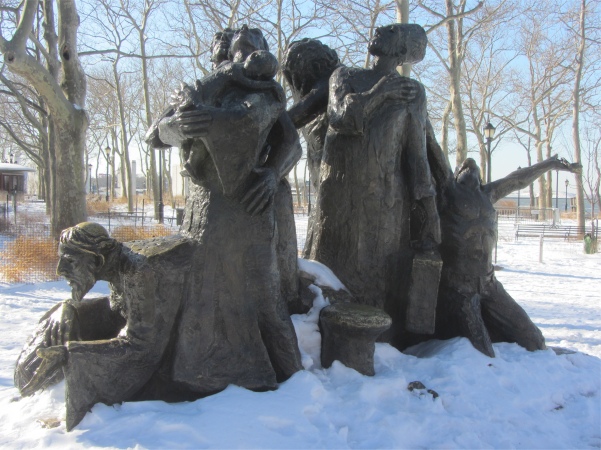From 1892 to 1954, over twelve million immigrants entered the United States through the portal of Ellis Island, a small island in New York Harbour. Ellis Island is located in the Upper Bay just off the New Jersey coast, within the shadow of the Statue of Liberty. Through the years, this gateway to the new world was enlarged from its original 3.3 acres to 27.5 acres mostly by landfill obtained from ship ballast and possibly excess earth from the construction of the New York City subway system.

Ellis Island Immigration Museum
|
I entered the imposing Immigration Building into a vast room, the Baggage Room. The museum has three floors of exhibits and galleries documenting the history of the island and immigration, but more importantly the immigrants' experiences. I found the audio recordings made by people who had actually been immigrants, as well as the written accounts, very moving. All of the exhibits and galleries were well laid out and highly informative.
Before being designated as the site of the first Federal immigration station by President Benjamin Harrison in 1890, Ellis Island had a varied history. The local Indian tribes had called it "Kioshk" or Gull Island. Due to its rich and abundant oyster beds and plentiful and profitable shad runs, it was known as Oyster Island for many generations during the Dutch and English colonial periods.
By the time Samuel Ellis became the island's private owner in 1774, the island had been called Kioshk, Oyster, Dyre, Bucking and Anderson's Island. In this way, Ellis Island developed from a sandy island that barely rose above the high tide mark, into a hanging site for pirates, a harbour fort, ammunition and ordinance depot named Fort Gibson, and finally into an immigration station.
From 1794 to 1890 (pre-immigration station period), Ellis Island played a mostly uneventful but still important military role in United States history. When the British occupied New York City during the duration of the Revolutionary War, its large and powerful naval fleet was able to sail unimpeded directly into New York Harbour.

Men Working in Baggage Room ca. 1910
|
Therefore, it was deemed critical by the United States Government that a series of coastal fortifications in New York Harbour be constructed just prior to the War of 1812. After much legal haggling over ownership of the island, the Federal government purchased Ellis Island from New York State in 1808.
Ellis Island was approved as a site for fortifications and on it was constructed a parapet for three tiers of circular guns, making the island part of the new harbour defence system that included Castle Clinton at the Battery, Castle Williams on Governor's Island, Fort Wood on Bedloe's Island and two earthworks forts at the entrance to New York Harbour at the Verrazano Narrows. The fort at Ellis Island was named Fort Gibson in honour of a brave officer killed during the War of 1812.
Prior to 1890, the individual states (rather than the Federal government) regulated immigration into the United States. Castle Garden in the Battery (originally known as Castle Clinton) served as the New York State immigration station from 1855 to 1890 and approximately eight million immigrants, mostly from Northern and Western Europe, passed through its doors.
These early immigrants came from nations such as England, Ireland, Germany and the Scandinavian countries and constituted the first large wave of immigrants that settled and populated the United States. Throughout the 1800s and intensifying in the latter half of the 19th century, ensuing political instability, restrictive religious laws and deteriorating economic conditions in Europe began to fuel the largest mass human migration in the history of the world.

Registry Room ca. 1910
|
It soon became apparent that Castle Garden was ill-equipped and unprepared to handle the growing numbers of immigrants arriving yearly. Unfortunately, compounding the problems of the small facility were the corruption and incompetence found to be commonplace at Castle Garden.
The Federal government intervened and constructed a new Federally-operated immigration station on Ellis Island. While the new immigration station on Ellis Island was under construction, the Barge Office at the Battery was used for the processing of immigrants.
The new structure on Ellis Island, built of "Georgia pine" opened on 1st January 1892. Annie Moore, a teenaged Irish girl, accompanied by her two brothers, entered history and a new country as she was the very first immigrant to be processed at Ellis Island. Over the next 62 years, more than 12 million were to follow through this port of entry.
While most immigrants entered the United States through New York Harbour (the most popular destination of steamship companies), others sailed into many ports such as Boston, Philadelphia, Baltimore, San Francisco, Savannah, Miami, and New Orleans. The great steamship companies like White Star, Red Star, Cunard and Hamburg-America played a significant role in the history of Ellis Island and immigration in general.
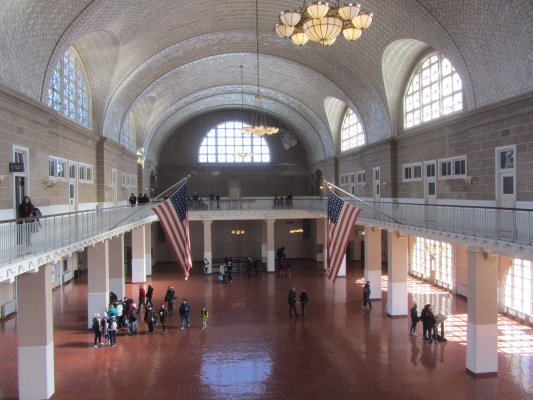
Registry Room Today
|
First and second class passengers who arrived in New York Harbour were not required to undergo the inspection process at Ellis Island. Instead, these passengers underwent a cursory inspection aboard ship, the theory being that if a person could afford to purchase a first or second class ticket, they were less likely to become a public charge in America due to medical or legal reasons.
The Federal government felt that these more affluent passengers would not end up in institutions, hospitals or become a burden to the state. However, first and second class passengers were sent to Ellis Island for further inspection if they were sick or had legal problems.
This scenario was far different for "steerage" or third class passengers. These immigrants travelled in crowded and often unsanitary conditions near the bottom of steamships with few amenities, often spending up to two weeks seasick in their bunks during rough Atlantic Ocean crossings.
Upon arrival in New York City, ships would dock at the Hudson or East River piers. First and second class passengers would disembark, pass through Customs at the piers and were free to enter the United States. The steerage and third class passengers were transported from the pier by ferry or barge to Ellis Island where everyone would undergo a medical and legal inspection.
During the early 1900s, immigration officials mistakenly thought that the peak wave of immigration had already passed. Actually, immigration was on the rise, and in 1907 more people immigrated to the United States than any other year, a record that would hold for the next 80 years. Approximately 1.25 million immigrants were processed at Ellis Island in that one year.
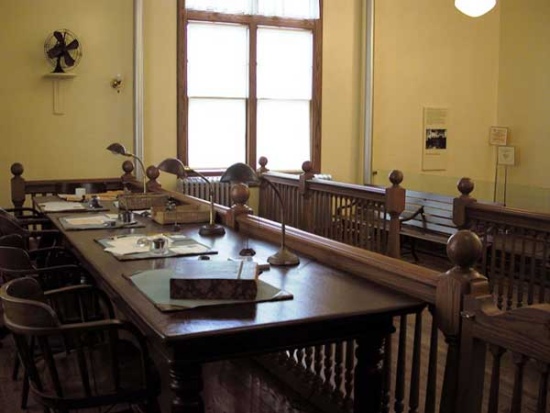
Board of Special Inquiry Hearing Room
|
Consequently, masons and carpenters were constantly struggling to enlarge and build new facilities to accommodate this greater than anticipated influx of new immigrants. Hospital buildings, dormitories, contagious disease wards and kitchens all were feverishly constructed between 1900 and 1915.
As the United States entered World War I, immigration to the United States decreased. Numerous suspected enemy aliens throughout the United States were brought to Ellis Island under custody. Between 1918 and 1919, detained suspected enemy aliens were transferred from Ellis Island to other locations in order for the United States Navy with the Army Medical Department to take over the island complex for the duration of the war.
During this time, regular inspection of arriving immigrants was conducted on board ship or at the docks. At the end of World War I, a big "Red Scare" spread across America and thousands of suspected alien radicals were interned at Ellis Island. Hundreds were later deported based upon the principal of guilt by association with any organizations advocating revolution against the Federal government.
In 1920, Ellis Island reopened as an immigration receiving station and 225,206 immigrants were processed that year. If the immigrant's papers were in order and they were in reasonably good health, the Ellis Island inspection process would last approximately three to five hours. The inspections took place in the Registry Room (or Great Hall), where doctors would briefly scan every immigrant for obvious physical ailments. Doctors at Ellis Island soon became very adept at conducting these "six second physicals."
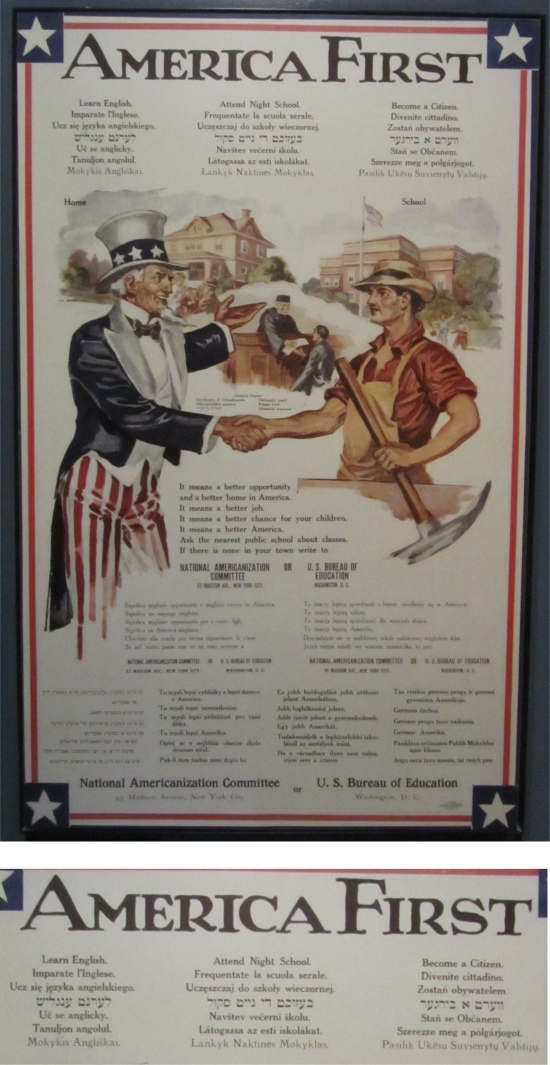
Where Have I Heard That Before? 1915 Poster
|
By 1916, it was said that a doctor could identify numerous medical conditions (ranging from anaemia to goitres to varicose veins) just by glancing at an immigrant. The ship's manifest log, that had been filled out back at the port of embarkation, contained the immigrant's name and his/her answers to twenty-nine questions. This document was used by the legal inspectors at Ellis Island to cross-examine the immigrant during the legal (or primary) inspection.
Despite the island's reputation as an "Island of Tears", the vast majority of immigrants were treated courteously and respectfully, and were free to begin their new lives in America after only a few short hours on Ellis Island. Only two percent of the arriving immigrants were excluded from entry. The two main reasons why an immigrant would be excluded were if a doctor diagnosed that the immigrant had a contagious disease that would endanger the public health or if a legal inspector thought the immigrant was likely to become a public charge or an illegal contract labourer.
Some immigrants, called "birds of passage," came to the United States to work, but did not intend to stay. When the American economy was strong, many Italian, Greek, Slavic, and British immigrants followed a seasonal pattern of migration. They came to the U.S. in the spring to find jobs in construction, agriculture, and mining, and returned home for the winter when most outdoor work shut down. Canadians and Mexicans, too, made frequent trips across the border, the Mexicans to harvest and plant crops in the Southwest; the Canadians to work in factories and textile mills in the North.
From the very beginning of the mass migration that spanned the years 1880 to 1924, an increasingly vociferous group of politicians and nativists demanded increased restrictions on immigration. Laws and regulations such as the Chinese Exclusion Act, the Alien Contract Labour Law and the institution of a literacy test barely stemmed this flood tide of new immigrants.
Actually, the death knell for Ellis Island, as a major entry point for new immigrants, began to toll in 1921. It reached a crescendo between 1921 with the passage of the Quota Laws and 1924 with the passage of the National Origins Act. These restrictions were based upon a percentage system according to the number of ethnic groups already living in the United States as per the 1890 and 1910 Census.
It was an attempt to preserve the ethnic flavour of the "old immigrants", those earlier settlers primarily from Northern and Western Europe. The perception existed that the newly arriving immigrants mostly from Southern and Eastern Europe were somehow inferior to those who arrived earlier.
After World War I, the United States began to emerge as a potential world power. United States embassies were established in countries all over the world, and prospective immigrants now applied for their visas at American consulates in their countries of origin. The necessary paperwork was completed at the consulate and a medical inspection was also conducted there.
After 1924, the only people who were detained at Ellis Island were those who had problems with their paperwork, as well as war refugees and displaced persons. Ellis Island still remained open for many years and served a multitude of purposes. During World War II, enemy merchant seamen were detained in the baggage and dormitory building. The United States Coast Guard also trained about 60,000 servicemen there. In November of 1954, the last detainee, a Norwegian merchant seaman named Arne Peterssen, was released, and Ellis Island officially closed.
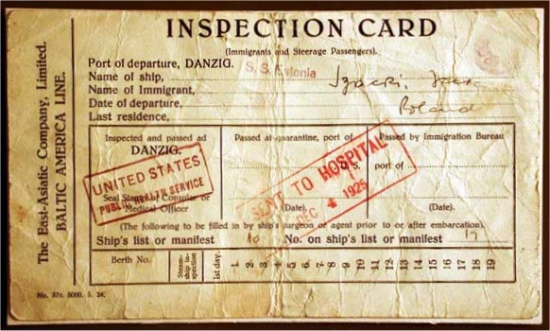
Inspection Card
|
I became aware as I slowly traversed the museum taking all this in, that people lingered here, taking their time to absorb the content. I wondered how many had ancestors who had entered through this small island.
I had squeezed every minute out of my visit to the island, and soon I would have to catch the last ferry back to Manhattan. As I left the building, I caught sight of a ranger, a stout chap about my age with a weatherworn face, sitting on a wall by the entrance. We exchanged pleasantries as I sat down beside him in the weak sunshine.
"Where are you from?" he asked.
"England, East Anglia," I replied.
"My family came over from Somerset in the 1870s," he informed me. "My father eventually settled in Pittsburgh, Pennsylvania. My mother's family came from Northern Ireland, and they settled in Brooklyn. My father went to work in Brooklyn, met my mother, and the rest is history," he related. We chatted for a while about his previous trips to Ireland and London.
"How long have you been working here?" I asked.
"26 years", was his response.
I was curious and asked, "Do you have to retire at a certain age?"
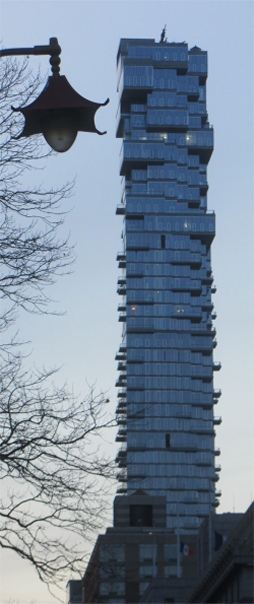
Bizarre High Rise
|
"Not as a park ranger. You can work as long as you want or can. Now I have just reached 65 last October, I can claim state benefit." We discussed what I had seen so far. "I live in New Jersey, Brooklyn is too gentrified now and very expensive to live in," he told me. We continued chatting about my situation, the drastic weather changes, avoided politics, my plans for the rest of my stay, and the dire state of Indian food in America. "Ha, I used to be a roadie with a pop band. We travelled all around Europe. One of the hands who lived over here was Irish, and whenever he went back to Britain he would have three Jalfrazis a day," he laughed. The old chap had mentioned a bar to look for, the White Horse, near Battery Park. "They serve good food and beer there, though today being St. Patrick's Day, you'll be lucky if you can get into it." He scratched his head trying to remember the exact location, but he couldn't recall.
He was a kind hearted, jovial soul with a good sense of humour. It was a shame to leave him, I enjoyed his company, but the last ferry was now berthed. We shook hands and parted the best of friends.
Back on tera firma I looked down a couple of streets the man had mentioned, but could not find the bar the man had mentioned.. However, I did find the Broadstone, advertising Irish ale and music, so in I went. It was throbbing inside, very lively with Irish reels blasting forth. I ordered a pint of Guinness, well it was St. Patrick's Day, and managed to grab a small table by a window.
Soon I was chatting to a young couple, Brandan and a woman whose name I never captured. They were from Belfast, had arrived yesterday, and were here for four days. Brendan pumped me for information on harbour tours, the Statue of Liberty and Ellis Island. I urged the couple to visit the sights I had been to earlier today, pointing out that the ferry trips would render a harbour cruise redundant anyway. I also recommended the Staten Island Ferry; the idea that it was free appealed to Brendan. "I had a pizza last night," he told me, " and it was small." He indicated the size; I wonder how many folk in the bar thought he was showing me the size of a fish he had caught. "And they charged me $35. The waitress was curt and tried to grab my plate before I finished, so I did not leave her a tip," he said triumphantly. We chatted a while, and I advised the couple that Chinatown was cheap and good. "That's where we are heading," he said with a glint in his eye. We shook hands and off they went to find Chinatown; neither had a map and obviously had no idea of the layout of the city, but if anyone can find a place, the Irish can.
A young woman parked herself next to me with a glass of wine and a pint of beer for her other half, who I presumed had gone to the restroom. I raised my glass, "Sláinte!" She echoed it back to me. I was not sure if she was repeating it without really understanding what I said. "Sláinte!" I said again, and she echoed it back to me again. She was American, lived in Jersey City, but worked in Manhattan. Oh, she understood "Sláinte!" perfectly, her surname was McGuire.
Two pints of Guinness down on an empty stomach, I needed to find food. It had been a very thought provoking day.
